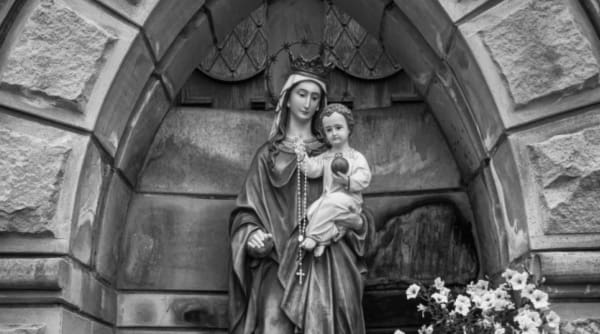One of the fond memories that I have of my time as an undergraduate student at Franciscan University of Steubenville was when I saw the midnight premiere of Mel Gibson’s The Passion of the Christ, on Ash Wednesday, February 25, 2004. I went into a packed theater with about two to three hundred men from Trinity Hall dorm. I had a midterm exam the following morning in Medieval Philosophy and was busy cramming my studies in before going to watch the movie. By the time the film ended, there was not a dry eye in the house. People walked out in reverential silence and love for the meditation that Mel Gibson presented onscreen of the price that Jesus paid for our redemption with his passion and death on the cross.
In our current time, Christians are having a similar experience with the Dallas Jenkins’ television series The Chosen over its depiction of the life of Jesus as portrayed in the gospels as they did eighteen years ago with Mel Gibson’s The Passion of the Christ. There are many beautiful, positive insights that people have received prayerfully through watching this television series in their own walk with the Lord. Yet in its recent Christmas special, “The Messengers,” its depiction of the Virgin Mary and the Birth of Jesus fell flat of conveying the full revealed truth given to us regarding the Perpetual Virginity of the Blessed Virgin Mary (virginitas in partu). This brings up the following questions: What is the Perpetual Virginity of the Blessed Virgin Mary and its place in the life of faith? What are the proper place and limits of artistic depictions of the life of Our Lord Jesus as depicted in the Gospel?
The Perpetual Virginity of the Blessed Virgin Mary (virginitas in partu) is the dogma that holds that Mary, the Mother of God, was virginal before, during, and after the birth of Jesus Christ. This belief of the perpetual virginity of the Blessed Virgin Mary has implications for the relationship between Jesus, the Church, and the individual disciple. The Church holds the belief that Mary was a virgin before the birth of Christ as expressed that she conceived Jesus “by the power of the Holy Spirit.” (Apostle’s Creed) This is also alluded to in Isaiah 7:14: “Therefore the Lord himself shall give you a sign. Behold a virgin shall conceive (Ecce virgo concipiet), and bear (et pariet) a son, and his name shall be called Emmanuel.” In Luke 1:28, we see Gabriel speak this prophecy directly to Mary at the Annunciation. Mary’s response is “How can this be since I know not man?” (quomodo fiet istud quoniam virum non cognosco? – Lk 1:34). In this question, Mary is not doubting what the Archangel Gabriel is telling her about her vocation but is questioning the causality of how God’s action would be carried out by means of her virginity. This is different from Zechariah’s response to the Archangel Gabriel’s message to him that he and Elizabeth will conceive a son, Saint John the Baptist, despite her struggles with sterility and her old age. His question inflects doubt where he states, “How shall I know this? For I am an old man, and my wife is advanced in years.” (unde hoc sciam ego enim sum senex et uxor mea processit in diebus suis – Lk 1:18) (Mark Miravalle, Introduction to Mary, Chapter 4, Kindle Edition). The Perpetual Virginity of Mary also implies that she had no marital relations with Saint Joseph and had no other children beyond Jesus, her firstborn. The root of this belief is found in Mary’s response to the Archangel Gabriel, “I know not man.” (Lk 1:34) Saint Thomas Aquinas as well as numerous Fathers of the Church interpreted these words to refer to a vow of virginity, in that it speaks of a permanent disposition that Mary lived all her life. (Summa Theologica, III, q. 28, a. 4 & q. 29, a. 2, reply obj. 3)
The Perpetual Virginity of Mary (virginitas in partu) also holds that at the appointed time Our Lord left the womb of Mary, he did so in a miraculous manner without physical violation of the bodily integrity of her virginity. The early church fathers, such as St. Justin Martyr (d. 107) and St. Iranaeus of Lyons (d. 202), held this belief as founded in Lk 1:28 and Isaiah 7:14. Their view can be summarized in the notion that “as light passes through glass without harm to the glass so did Jesus pass through the womb of Mary without harm to her virginity.” (Mark Miravalle, Introduction to Mary, Chapter 4, Kindle Edition) Saint Augustine would teach also that “It behooved that our Head, by a notable miracle, should be born, after the flesh, of a virgin, that He might thereby signify that His members would be born, after the Spirit, of a virgin Church.” (De Sacra Virginitatis, n. 6).
Saint Ambrose, the great mentor, and friend of Saint Augustine, would also affirm this same teaching regarding the Perpetual Virginity of Mary (virginitas in partu) especially in his famous Christmas Hymn, Veni, Redemptor Gentium. Saint Thomas Aquinas later would cite this same hymn of Saint Ambrose as justification that “in order to manifest His Godhead, he was born of the Virgin.” (Summa Theologica, III, q. 28, a. 2) This hymn, alongside other references to the perpetual virginity of Mary in the Nicene Creed and in the Roman Canon (Eucharistic Prayer I) are examples of the principle of “The law of prayer is the law of belief” (lex orandi lex credendi). This principle teaches that “the Church’s liturgy expresses her faith and gives us insight into the mind of the Church as she lives out that faith in her public worship.” (Brian Graebe, Vessel of Honor, 47)
Saint Thomas Aquinas would later go on to describe the fittingness of the perpetual virginity of the Blessed Virgin Mary, building from this original point:
It is fitting for four reasons that Christ should be born of a virgin. First, in order to maintain the dignity of the Father Who sent Him. For since Christ is the true and natural Son of God, it was not fitting that He should have another father than God: lest the dignity belonging to God be transferred to another.
Secondly, this was befitting to a property of the Son Himself, Who is sent. For He is the Word of God: and the word is conceived without any interior corruption: indeed, interior corruption is incompatible with perfect conception of the word. Since therefore flesh was so assumed by the Word of God, as to be the flesh of the Word of God, it was fitting that it also should be conceived without corruption of the mother.
Thirdly, this was befitting to the dignity of Christ’s humanity in which there could be no sin, since by it the sin of the world was taken away, according to John 1:29: “Behold the Lamb of God” (i.e. the Lamb without stain) “who taketh away the sin of the world.” Now it was not possible in a nature already corrupt, for flesh to be born from sexual intercourse without incurring the infection of original sin. Whence Augustine says (De Nup. et Concup. i): “In that union,” viz. the marriage of Mary and Joseph, “the nuptial intercourse alone was lacking: because in sinful flesh this could not be without fleshly concupiscence which arises from sin, and without which He wished to be conceived, Who was to be without sin.
Fourthly, on account of the very end of the Incarnation of Christ, which was that men might be born again as sons of God, “not of the will of the flesh, nor of the will of man, but of God” (John 1:13), i.e. of the power of God, of which fact the very conception of Christ was to appear as an exemplar. (Summa Theologica, III, q. 28, a. 2).
Thomas would later speak of Mary’s pains in childbirth in the following manner:
The pains of childbirth are caused by the infant opening the passage from the womb. Now it has been said above (28, 2, Replies to objections), that Christ came forth from the closed womb of His Mother, and, consequently, without opening the passage. Consequently there was no pain in that birth, as neither was there any corruption; on the contrary, there was much joy therein for that God-Man “was born into the world,” according to Isaiah 35:1-2: “Like the lily, it shall bud forth and blossom, and shall rejoice with joy and praise.” (Summa Theologica, III, q. 35, a. 6)
Pope Paul IV, at the Council of Trent, would later affirm the perpetual virginity of Mary, admonishing those who assert that “the same most blessed Virgin Mary is not the true mother of God and did not always persist in the integrity of virginity; namely, before giving birth, in giving birth, and perpetually after giving birth.” (DH 1880 as cited in Graebe, Vessel of Honor, 51)
Pope Pius XII would speak of the miraculous birth of Jesus Christ and Our Lady’s motherhood in relation to her Perpetual Virginity in the following way:
[Mary], whose sinless soul was filled with the divine spirit of Jesus Christ above all other created souls, who “in the name of the whole human race” gave her consent “for a spiritual marriage between the Son of God and human nature.” Within her virginal womb Christ our Lord already bore the exalted title of Head of the Church; in a marvelous birth she brought Him forth as the source of all supernatural life, and presented Him newly born, as Prophet, King and Priest to those who, from among Jews and Gentiles, were the first to come to adore Him. (Mystici Corporis, n. 110)
The Second Vatican Council would expand upon this insight by teaching:
This union of the Mother with the Son in the work of salvation is made manifest from the time of Christ’s virginal conception up to His death…This union is manifest also at the birth of Our Lord, who did not diminish His mother’s virginal integrity but sanctified it. (Lumen Gentium, n. 57)
The Catechism of the Catholic Church would also reaffirm this teaching on the Perpetual Virginity of Mary in stating:
The deepening of faith in the virginal motherhood led the Church to confess Mary’s real and perpetual virginity even in the act of giving birth to the Son of God made man. In fact, Christ’s birth “did not diminish his mother’s virginal integrity but sanctified it.” And so the liturgy of the Church celebrates Mary as Aeiparthenos, the “Ever-virgin”. (CCC, n. 499)
John Paul II would also teach in relation to the Perpetual Virginity of Mary that the body also expresses the interior depths of the person. Mary’s physical virginity is an external expression of the mystery of her perfect interior virginity, and because Mary was to be a Virgin in her spiritual and physical virginity was perfect and united to each other. (Cf. Mulieris Dignitatem, n. 17-22)
The importance of the Dogma of the Perpetual Virginity of the Blessed Virgin Mary is that it implies that Mary was the perfect disciple of Jesus her son. The Catechism of the Catholic Church speaks of this reality in the following way:
Mary’s virginity manifests God’s absolute initiative in the Incarnation…By his virginal conception, Jesus, the New Adam, ushers in the new birth of children adopted in the Holy Spirit through faith. The acceptance of this life is virginal because it is entirely the Spirit’s gift to man. The spousal character of the human vocation in relation to God is fulfilled perfectly in Mary’s virginal motherhood. Mary is a virgin because her virginity is the sign of her faith “unadulterated by any doubt”, and of her undivided gift of herself to God’s will. It is her faith that enables her to become the mother of the Savior. (CCC n. 503-507)
In watching The Chosen Christmas episode, “The Messengers,” It is important to note its strengths alongside its errors and limits. We must not relativize the mystery of faith contained in scripture, tradition, and the constant magisterial teachings of the Church through artistic depictions of the life of Christ as seen in visual art. Even in artistic depictions that are free from theological error, we should always see the sacramental unity between the artistic sign and the mystery it contains and the limits of that unity on the human side. Relevancy and reaching people where they are in our current time are important factors for effective evangelization and for overall discipleship with Jesus in faith. Yet faith always has a timeless element that speaks to every age. It is important that we do not let an oversentimentality get in the way from God acting, whether it is through art or in living in our own age of human history. When relevancy becomes the sole driving force, we risk neutering the Gospel of its meaning and power to gain the world.
As we watch The Chosen episode, “The Messengers” this Christmas, may we affirm the good, the true, the beautiful in its depiction of the life of Jesus and Mary. This good can be a source of spiritual consolation in our prayer. At the same time, may we also be given the wisdom and grace in faith to see the human limits and errors of such artistic depictions of the life of Our Lord in the realm of faith, theology, and historical depiction, especially when it comes from a non-Catholic perspective. May this wisdom give us the faith and clarity to not confuse the artistic depiction for the actual historical events and mysteries of the lives of Jesus and Mary conveyed to us through the faith of the Church. In doing so may we come to grow in true adoration and love of Jesus, our infant King and God, moving out of the shadows and symbols of consolation that art can bring to our prayer into the fullness of the truth of the mystery of faith that they can bring to us.
Photo by Eugene Lagunov on Unsplash.




